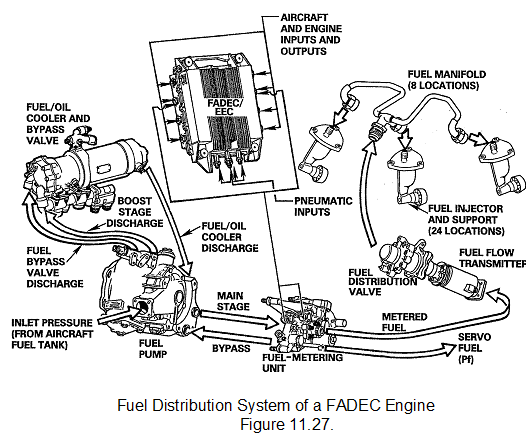Full-authority digital electronic control:
The supervisory control was a step toward the full-authority, fully redundant EEC. It controls all engine functions and eliminates the need for the backup hydromechanical control used in the supervisory system. The modern full¬ authority EEC is a digital electronic device called a full-authority digital electronic control, or FADEC.
One of the basic purposes of the FADEC is to reduce flight crew workload. This is achieved by the FADEC's control logic, which simplifies power settings for all engine operating conditions. The throttle position is used to achieve consistent engine settings regardless of flight or environmental conditions.
The FADEC establishes engine power through direct closed-loop control of the engine ratio thrust-rating parameter. The required thrust is calculated as a function of throttle lever angle, altitude, Mach number, and total air temperature. The air data computer supplies altitude, Mach number, and total air temperature information, and sensors provide measurements of engine temperatures, pressures, and speeds. This data is used to provide automatic thrust control, engine limit protection, transient control, and engine starting.
FADEC uses a pre-programmed schedule to obtain the correct thrust for the various throttle lever angles, and it provides the correct thrust for any chosen angle during changing flight or environmental conditions.
To get the desired thrust, the pilot has only to set the throttle lever to a position which aligns the thrust command from the control with the reference indicator from the aircraft thrust management computer. The control system automatically accelerates or decelerates the engine to the desired level without the pilot having to continually monitor the thrust gauge. Once a power setting has been selected, the FADEC maintains it until the throttle lever position is changed.
A constant throttle lever angle setting can be used for takeoff and climb. In addition, since the pilot sets engine thrust , and the system controls the thrust by using a given throttle lever angle, the same thrust rating will be obtained on each engine at the same throttle position. This eliminates throttle stagger.
The FADEC has many advantages over both the hydromechanical and supervisory EEC. Some of these are:
• It requires no engine trimming
• It ensures improved engine starts
• It provides a constant idle speed with changes in atmospheric conditions and changing service bleed air requirements
• It saves fuel by providing improved engine bleed air management
• It fully modulates the active clearance control (ACC) system (if fitted)
• It ensures more repeatable engine transients due to the higher precision of its digital computer
• It provides engine limit protection by automatically limiting critical engine pressures and speeds
A typical FADEC system is that used in some of the Pratt and Whitney 4000 series engines currently in service. A brief explanation of how the system works follows.
Fuel Distribution and Control Components

Components controlling and distributing the fuel to the burners include:
• FADEC/EEC
• Fuel/oil cooler and by pass valve
• Fuel metering unit
• Fuel distribution valve
• Fuel injector supply manifolds
• Fuel injectors